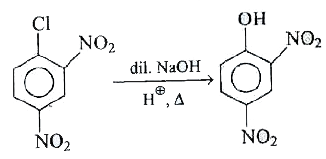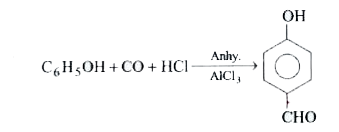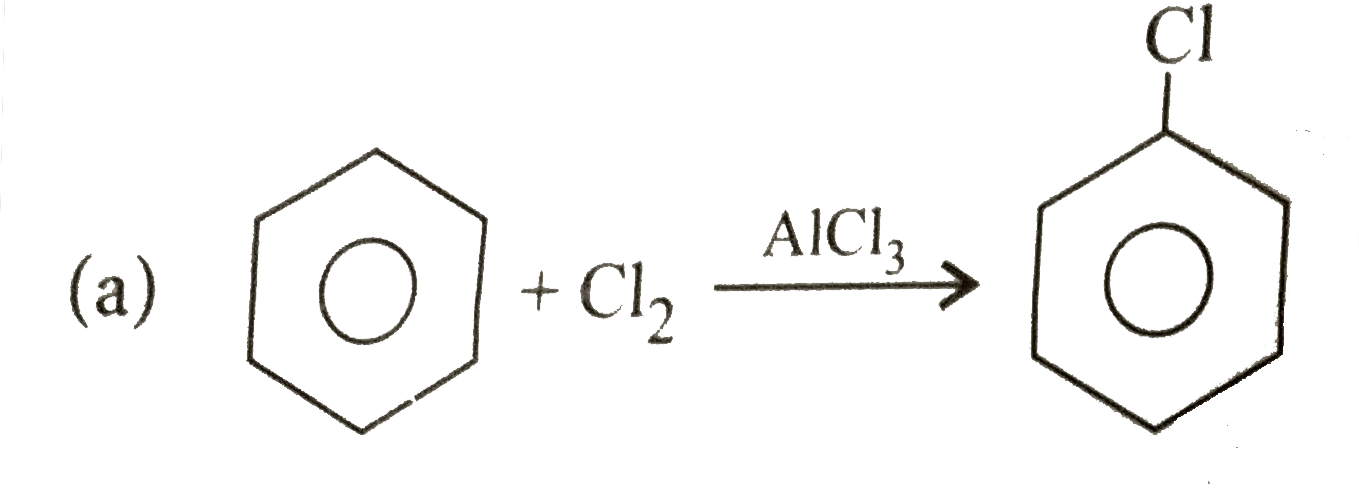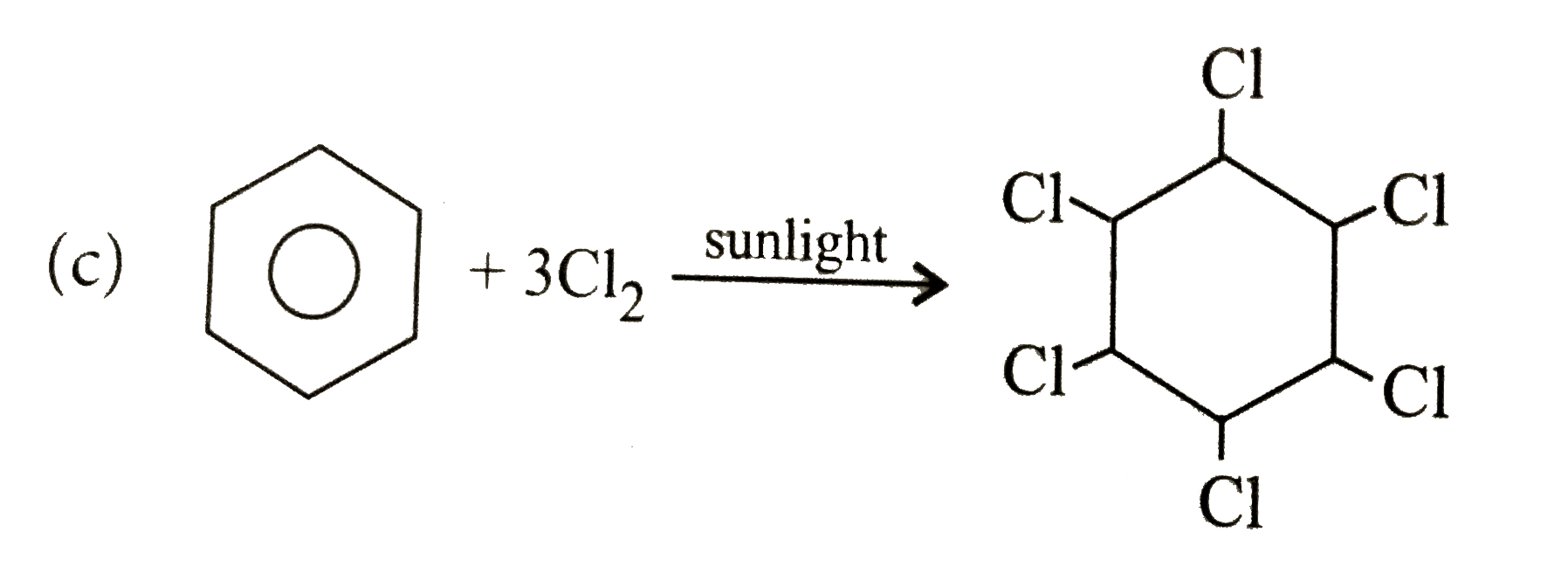Among the following, the reaction that proceeds through an electrophilic substitution, is :




The correct Answer is:D
To determine which reaction proceeds through an electrophilic substitution mechanism, we will analyze each of the given options step by step.
Step 1: Analyze Option A
- Reaction: Benzene diazonium chloride treated with Cu2Cl2.
- Mechanism: The reaction involves the formation of an aryl cation (aryl carbocation) as an intermediate after the release of N2 gas. A nucleophile (Cl-) then attacks this cation.
- Conclusion: This reaction follows the mechanism of nucleophilic substitution (AR SN1), not electrophilic substitution.
Step 2: Analyze Option B
- Reaction: Benzene ring reacts with Cl2 in the presence of AlCl3.
- Mechanism: Here, Cl2 interacts with AlCl3 to form a Cl+ electrophile. This Cl+ then attacks the benzene ring, forming a sigma complex (an arenium ion) as an intermediate. A hydrogen atom is then abstracted, resulting in the formation of chlorobenzene and regenerating AlCl3.
- Conclusion: This reaction is a classic example of electrophilic substitution, where Cl+ replaces a hydrogen atom on the benzene ring.
Step 3: Analyze Option C
- Reaction: UV light is used to initiate a reaction.
- Mechanism: In the presence of UV light, free radicals are generated, leading to a free radical addition reaction.
- Conclusion: This is not an electrophilic substitution reaction, but rather a free radical mechanism.
Step 4: Analyze Option D
- Reaction: A compound is treated with HCl and heated.
- Mechanism: H+ from HCl attacks a lone pair of electrons on oxygen, leading to the formation of a carbocation. Water leaves as a good leaving group, resulting in a substitution product.
- Conclusion: This is a nucleophilic substitution (SN2) reaction, not an electrophilic substitution.
Final Conclusion
After analyzing all options, the only reaction that proceeds through an electrophilic substitution mechanism is Option B (benzene with Cl2 in the presence of AlCl3).
- Reaction: Benzene diazonium chloride treated with Cu2Cl2.
- Mechanism: The reaction involves the formation of an aryl cation (aryl carbocation) as an intermediate after the release of N2 gas. A nucleophile (Cl-) then attacks this cation.
- Conclusion: This reaction follows the mechanism of nucleophilic substitution (AR SN1), not electrophilic substitution.
- Reaction: Benzene ring reacts with Cl2 in the presence of AlCl3.
- Mechanism: Here, Cl2 interacts with AlCl3 to form a Cl+ electrophile. This Cl+ then attacks the benzene ring, forming a sigma complex (an arenium ion) as an intermediate. A hydrogen atom is then abstracted, resulting in the formation of chlorobenzene and regenerating AlCl3.
- Conclusion: This reaction is a classic example of electrophilic substitution, where Cl+ replaces a hydrogen atom on the benzene ring.
- Reaction: UV light is used to initiate a reaction.
- Mechanism: In the presence of UV light, free radicals are generated, leading to a free radical addition reaction.
- Conclusion: This is not an electrophilic substitution reaction, but rather a free radical mechanism.
- Reaction: A compound is treated with HCl and heated.
- Mechanism: H+ from HCl attacks a lone pair of electrons on oxygen, leading to the formation of a carbocation. Water leaves as a good leaving group, resulting in a substitution product.
- Conclusion: This is a nucleophilic substitution (SN2) reaction, not an electrophilic substitution.
After analyzing all options, the only reaction that proceeds through an electrophilic substitution mechanism is Option B (benzene with Cl2 in the presence of AlCl3).
Topper's Solved these Questions
- BOOK - ICSECHAPTER - HYDROCARBONS EXERCISE - TRUE OR FALSE TYPE QUESTIONS35videos
HYDROCARBONS
- BOOK - ICSECHAPTER - HYDROCARBONS EXERCISE - FILL IN THE BLANKS TYPE QUESTIONS22videos
HYDROCARBONS
- BOOK - ICSECHAPTER - HYDROCARBONS EXERCISE - ESSAY (LONG ANSWER) TYPE QUESTIONS28videos
HYDROCARBONS
- BOOK - ICSECHAPTER - EQUILIBRIUM EXERCISE - NCERT TEXT-BOOK EXERCISE109videos
EQUILIBRIUM
- BOOK - ICSECHAPTER - HYDROGENEXERCISE - NCERT TEXT-BOOK EXERCISE (With Hints and Solutions)53videos
HYDROGEN
Similar Questions
Knowledge Check
- Question 1 - Select One
 , this reaction proceed through : Aelectrophilic additionBbenzyne intermediateCnucleophilic aromatic substitutionDoxirane
, this reaction proceed through : Aelectrophilic additionBbenzyne intermediateCnucleophilic aromatic substitutionDoxirane - Question 2 - Select One
Which of the following reactions is not an example of electrophilic substitution ?
AC6H6++NO2→C6H5NO2+H+BC6H5+CH3ClAlCl3−−→C6H5−CH3+HClCC6H6+Cl2UV light−−−−→C6H6Cl6DC6H5OH+CO+HClAnhy−−→AlCl3

- Question 3 - Select One
Which of the following reactions is not an example of electrophilic substitution in benzene ring?
A B
B C
C D
D
The increasing order of reactivity of the following compounds towards aromatic electrophilic substitution reaction is :
 View Solution
View SolutionHow many of the following are activated towards electrophilic aromatic substitution reactions?
 View Solution
View SolutionWhich of the following steps is not correct in the mechanism of electrophilic substitution of benzene?
View SolutionThe ether that undergoes electrophilic substitution reactions is
View SolutionWhich of the following are more reactive than diphenyl in electrophilic aromatic substitution reaction ?
View Solution

